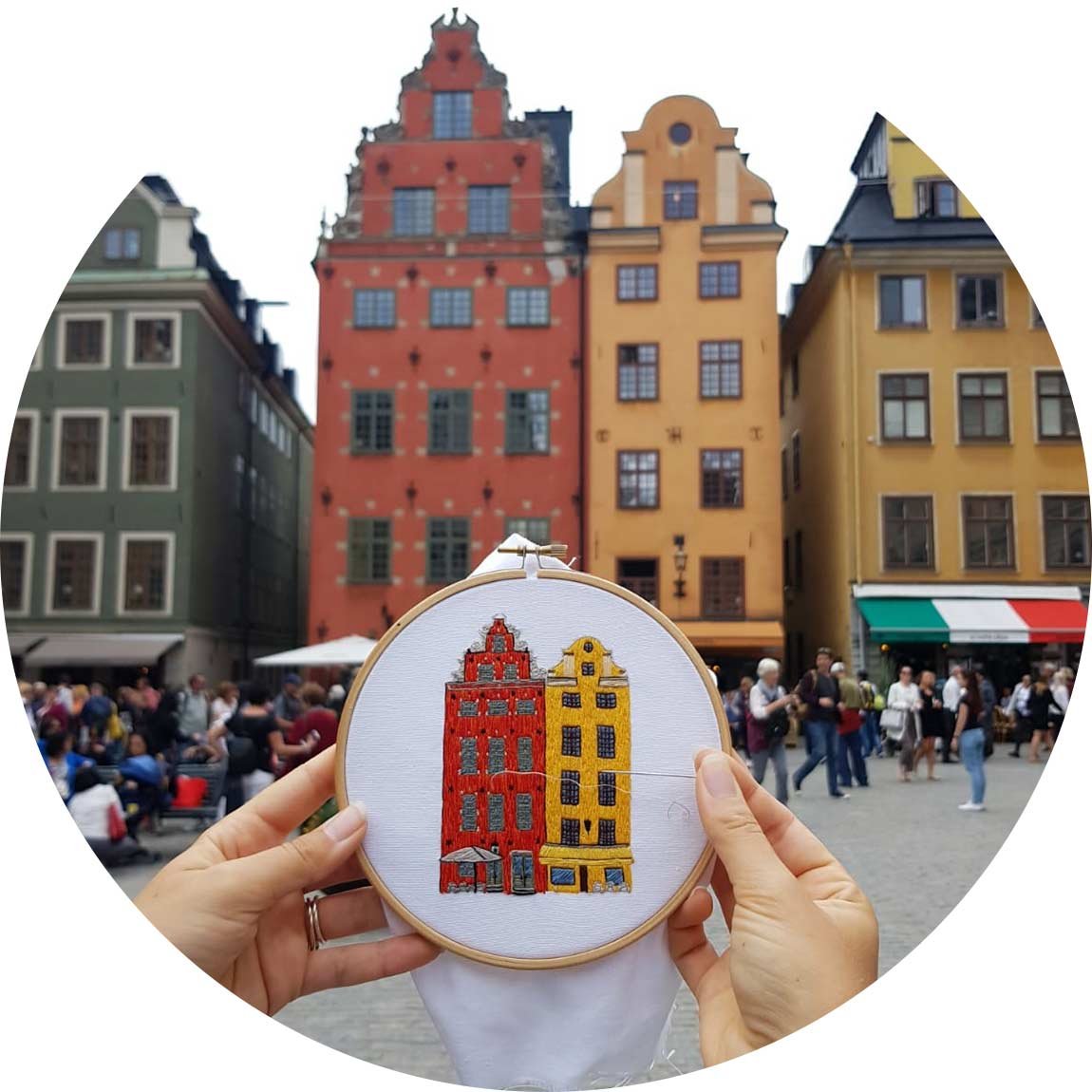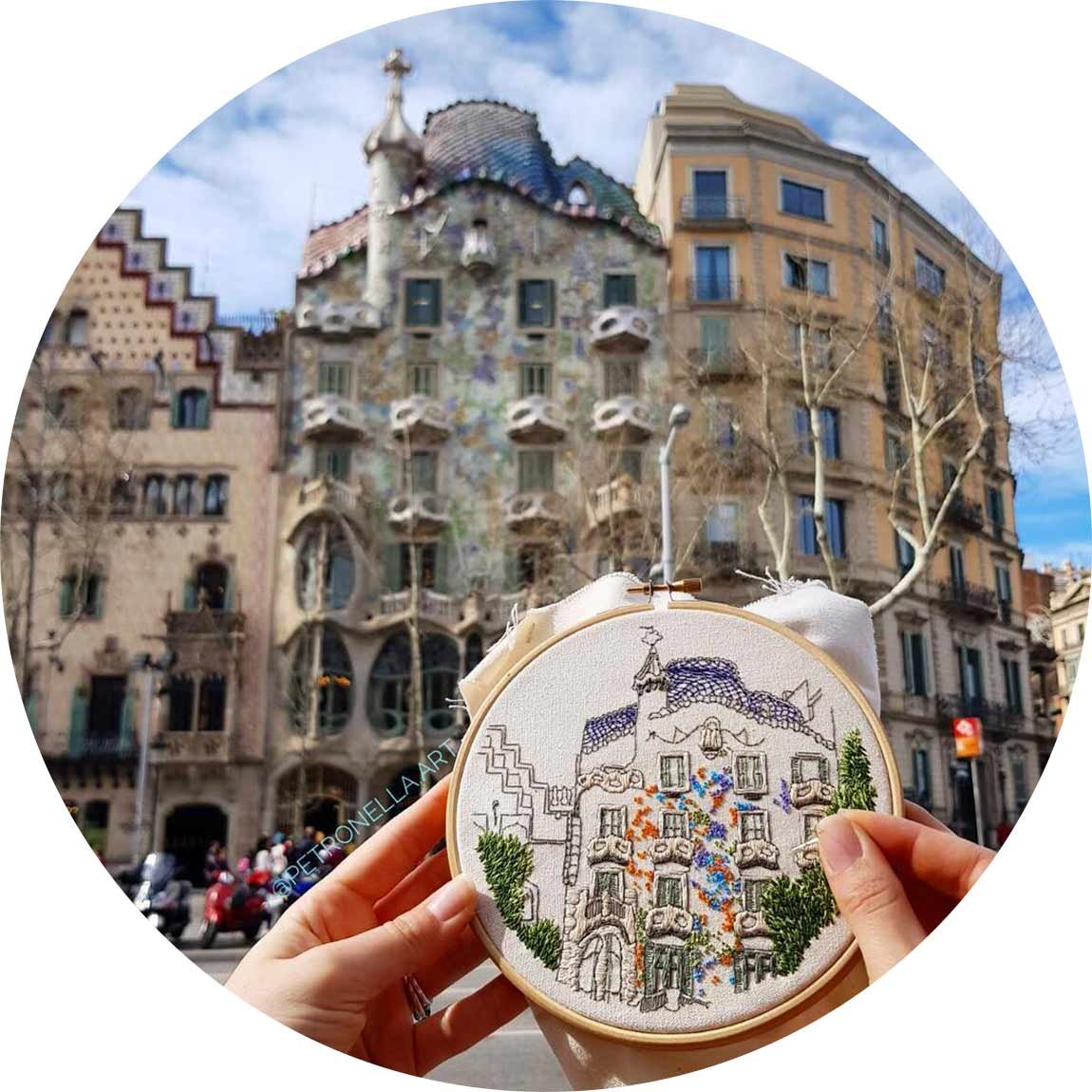Architectural Hand Embroidery Designs
Architectural Hand Embroidery Designs, are the perfect blend between illustration and embroidery. When we first began to stitch, we missed the presence of new and modern designs. It was Charles who first came up with the idea that I should embroider my architectural sketches.
Since the first attempt I was hooked. Thanks to the power of thread and needle, I was able to create a 3D drawing. My illustration rather became a touchable drawing, which was absolutely captivating. Instead of only seeing the lines grow, you can feel them too. When you run your fingers along the threads you can even feel the flow of a building.
Embroidery of Rue Rembrandt in Paris by Charles and Elin
This was one of my first Architectural hand embroidery designs inspired from the majestic buildings on Rue Rembrandt in Paris.
But How Can A Building Have Flow?
Whenever we teach workshops, we often get asked this question. The answer comes down to observation.
The closer you observe different objects in your surrounding, the better you will see the smaller fibres and structures that makes up the object.
For example, when you observe a building, do you have the impression that the walls rise high up or are spread out wide? Depending on the shape and size of a house, it’s usually vertical or horizontal structures that stand out.
This hand embroidery pattern of Gamla Stan, Stockholm fits perfectly into a hoop of 15cm (6") or larger. The pattern will be sent to your email as an instantly downloadable PDF immediately after purchase.
The pdf also includes
🎨 colour guide
🔖 stitch guide
📖 general technique guide so that you can embroider the design with confidence.
Hence, when you recreate architectural sceneries in modern hand embroidery designs, you base your stitches off these observations.
If a building is tall and high, you will align your stitches in a vertical fashion. The opposite is true for for example one floor houses that rather spread broadly.
The Stockholm embroidery pattern that you see on the image to the left is a perfect example of vertical structures. To emphasize the height of the building, you make sure to align all your stitches vertically.
You can either use the long short stitch technique or align vertical rows of split stitches.
Our philosophy is that whatever technique that feels the most natural to you, is the best technique. Because to embroidery should be a practise of freedom.
Thus, to be able to freely experiment with your needlework is essential for creative fulfilment to flourish.
Most of our Architectural Hand Embroidery Designs are inspired from buildings or street scenes that we’ve visited or dream to travel to. Thus, you can see the original buildings of the Stockholm embroidery pattern on the image to the right.
Architectural Hand Embroidery Designs Allow You To Travel In Time
Considering the slow process of hand embroidery, you have time to get a deeper connection with the place you stitch. This is just another reason why I fell in love with the architectural style. In addition to creating a unique embroidered art work, I am able to become part of the location’s history.
To use the Stockholm design as an example again, it shows the strong historical influence. Most of the original buildings in the Old Town of Stockholm originate from the 13th-14th century! Thus, the rusty red and deep yellow are no longer modern colour choices. But rather, they’re connected to the rich history of the location.
This hand embroidery pattern of Casa Batllo in Barcelona fits perfectly into a hoop of 15cm (6") or larger. The pattern will be sent to your email as an instantly downloadable PDF immediately after purchase.
The pdf also includes
🎨 colour guide
🔖 stitch guide
📖 general technique guide so that you can embroider the design with confidence.
Another of our architectural hand embroidery designs is the world famous Casa Batlló building. However, instead of using long and short stitch or split stitches for the walls, we’ve unconventionally used French knots.
Thanks to the French knots you can capture the tiles, which contribute to the building’s character.
Furthermore, the French knots add texture and a more advanced look to the design. However, don’t forget that it’s still the basic techniques. It’s just the combination of them and the thinner threads that changes the impression.
Step Out Of The Traditional Needlework Box
As Charles and I explored the architectural style further, it became clear that we took a stand away from the traditional stitchery box. The most important isn’t the name of the technique. Rather it’s the impression that the technique gives ones it’s stitched.
In other words, a French knot can be used for mini florals one day and mosaic tiles another. The only limitation is your own imagination!
Below you can see a process image in front of Casa Battló in Barcelona. We try to go back to the inspiration source as often as we can to connect to the embroideries to their origins. It has now become an important part of our creative process.
Online courses
We also offer online Masterclasses on the Charles and Elin Academy for both complete beginners and seasoned stitchers looking to freshen up their repertoire.
And if you, just like us, find embroidery to be a part of your creative self-care routine, you’d definitely want to check out the Academy membership. We have designed it as the best embroidery membership by artists for artists to encourage you to make art a part of your every day life.
For a small monthly fee (No commitment time) you can access ALL our courses + continuous updates in one place. There are for example courses on Architectural hand embroidery and Architectural thread-painting, Embroidery on clothes, Thread-Sketching and much more!
Charles and Elin Academy
Click the image to learn more about the membership
Thanks for reading along!
xo Elin




